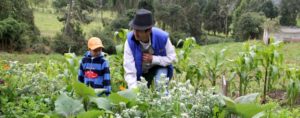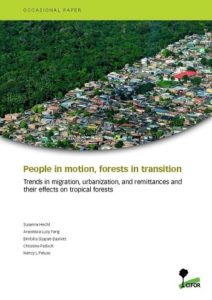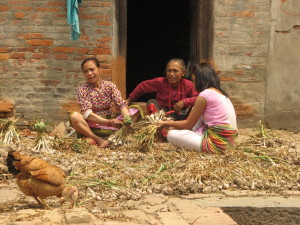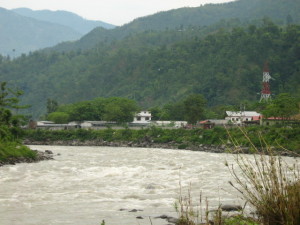Presented by Peter Cronkleton of the Center for International Forestry Research (CIFOR) at the CIFOR Annual Meeting on Oct. 4, 2018.
|
Posted by
FTA COMMUNICATIONS TEAM |
Presented by Peter Cronkleton of the Center for International Forestry Research (CIFOR) at the CIFOR Annual Meeting on Oct. 4, 2018.
|
Posted by
FTA COMMUNICATIONS TEAM |
Presented by Bimbika Sijapati Basnett of the Center for International Forestry Research (CIFOR) at the World Bank Conference on Land and Poverty on March 21, 2018, in Washington, DC.
|
Posted by
FTA COMMUNICATIONS TEAM |
Presented by Kartika Sari Juniwaty from the Center for International Forestry Research (CIFOR) at the World Bank Conference on Land and Poverty on March 21, 2018, in Washington, DC.
|
Posted by
FTA COMMUNICATIONS TEAM |
Presented by Peter Cronkleton from the Center for International Forestry Research (CIFOR) at the World Bank Conference on Land and Poverty, on March 21, 2018, in Washington, DC.
|
Posted by
FTA COMMUNICATIONS TEAM |

LANDac, the Netherlands Academy on Land Governance for Equitable and Sustainable Development, held its annual international conference on June 28-29 in Utrecht, the Netherlands.
Titled “Land governance and (im)mobility”, the conference explored the nexus between land acquisition, displacement and migration.
On the second day of the event, the wide range of parallel sessions included “‘Good Enough Tenure’ in Sustainable Forest and Land Management”, organized by Tropenbos International (TBI), in collaboration with the universities of Wageningen, Freiburg, Campinas and Kyoto, Kadaster Internationaal, the Center for International Forestry Research (CIFOR) and the CGIAR Research Program on Forests, Trees and Agroforestry (FTA).
The session discussed the practical implications of the increasing evidence from research and experiences in different parts of the world on the value and scope of so-called ‘good enough tenure’ arrangements for international and national policymakers and investors.
The main message that emerged from the panel session was that all players need to think beyond formal land regularization to provide enabling conditions for smallholders to secure property rights and incentives for investment.
A lack of formally recognized land and resource property has always been a constraint for small-scale farmers and forest communities. Mainstream land governance focusses largely on tenure regularization as a means to provide security. Smallholders without such formal tenure tend to be excluded from external funding streams, because banks, other private investors, governmental agencies and even some donors often require land titles as collateral to mitigate the risk of default from failed investment.
As a result, these actors have not been able to deal effectively with the mobility and the complex local reality, including the local needs and opportunities that exist in rural and forest areas in tropical countries.
The four panelists – Marieke van der Zon of Wageningen University, Kyoto University and TBI; Peter Cronkleton of CIFOR; Bastian Reydon of Universidade Estadual de Campinas’ Land Governance Group; and Benno Pokorny of University Freiburg – provided hands-on examples from Latin America, providing evidence that there is a variety of formal, informal and semiformal tenure situations and arrangements in these areas.
In many cases these informal, traditional and semiformal property rights are considered good enough for social and economic development and for conservation, as they are respected, upheld and protected by strong local institutions. These good-enough tenure right arrangements should be fully acknowledged as a valuable “local institutional capital” for making trustful and secure arrangements between local smallholders and external actors to engage, to invest and collaborate on a reciprocal basis.
They must therefore play a much more prominent starting point in promoting sustainable, inclusive and equitable development, with the panelists emphasizing the need to understand the local specificity of arrangements, advocating a “fit-for-purpose and place” approach.
Read the panelists’ abstracts:
View the presentations from the session:
Adapted from the article first published by Tropenbos International.
|
Posted by
FTA COMMUNICATIONS TEAM |

LANDac, the Netherlands Academy on Land Governance for Equitable and Sustainable Development, held its annual international conference on June 28-29 in Utrecht, the Netherlands.
Titled “Land governance and (im)mobility”, the conference explored the nexus between land acquisition, displacement and migration.
On the second day of the event, the wide range of parallel sessions included “‘Good Enough Tenure’ in Sustainable Forest and Land Management”, organized by Tropenbos International (TBI), in collaboration with the universities of Wageningen, Freiburg, Campinas and Kyoto, Kadaster Internationaal, the Center for International Forestry Research (CIFOR) and the CGIAR Research Program on Forests, Trees and Agroforestry (FTA).
The session discussed the practical implications of the increasing evidence from research and experiences in different parts of the world on the value and scope of so-called ‘good enough tenure’ arrangements for international and national policymakers and investors.
The main message that emerged from the panel session was that all players need to think beyond formal land regularization to provide enabling conditions for smallholders to secure property rights and incentives for investment.
A lack of formally recognized land and resource property has always been a constraint for small-scale farmers and forest communities. Mainstream land governance focusses largely on tenure regularization as a means to provide security. Smallholders without such formal tenure tend to be excluded from external funding streams, because banks, other private investors, governmental agencies and even some donors often require land titles as collateral to mitigate the risk of default from failed investment.
As a result, these actors have not been able to deal effectively with the mobility and the complex local reality, including the local needs and opportunities that exist in rural and forest areas in tropical countries.
The four panelists – Marieke van der Zon of Wageningen University, Kyoto University and TBI; Peter Cronkleton of CIFOR; Bastian Reydon of Universidade Estadual de Campinas’ Land Governance Group; and Benno Pokorny of University Freiburg – provided hands-on examples from Latin America, providing evidence that there is a variety of formal, informal and semiformal tenure situations and arrangements in these areas.
In many cases these informal, traditional and semiformal property rights are considered good enough for social and economic development and for conservation, as they are respected, upheld and protected by strong local institutions. These good-enough tenure right arrangements should be fully acknowledged as a valuable “local institutional capital” for making trustful and secure arrangements between local smallholders and external actors to engage, to invest and collaborate on a reciprocal basis.
They must therefore play a much more prominent starting point in promoting sustainable, inclusive and equitable development, with the panelists emphasizing the need to understand the local specificity of arrangements, advocating a “fit-for-purpose and place” approach.
Read the panelists’ abstracts:
View the presentations from the session:
Adapted from the article first published by Tropenbos International.
|
Posted by
FTA COMMUNICATIONS TEAM |
In a series of four videos and associated articles, the Center for International Forestry Research‘s (CIFOR) Forests News looks at migration research in Nepal, and how migration impacts lives and landscapes in the village of Nalma.
The importance of migration to rural livelihoods in Nepal is not being recognized in forestry policy or by donors – and nor is the diversity of women’s experience, argues a chapter of Gender and Forests: Climate Change, tenure, Value Chains and Emerging Issues, which was coedited by Carol J Colfer, CIFOR and FTA scientist Bimbika Sijapati Basnett, and FTA gender coordinator Marlene Elias.
Thirty percent of Nepal’s GDP comes from remittances – the second highest proportion in the world. Around half a million people, or eight percent of Nepal’s total population, applied for a permit to work abroad in 2014 – 94 percent of them were men – and that does not include the many unregistered migrants or those who migrated within the country. Despite this, Nepal’s recent Forest Sector Strategy (2012-2022) mentions migration just once.
First up in the series, Sijapati Basnett talks about her research in Nalma in Unpacking migration and gender in Nepal. The video is accompanied by the article Unpacking migration and gender in Nepal’s community forests, which considers that changing migration patterns bring both burdens and benefits for women.
Second, in Left behind in Nepal: Sita’s story, the series looks at Sita Pariyar, a 29-year-old mother of two living in Nalma who has balanced housework, childcare and field work since her husband moved to Qatar as a migrant worker. Nearly three-quarters of Nepal’s young male population now works overseas, sending money back to their families in the form of remittances that contribute almost 30 percent of the country’s gross domestic product. On the home front, women, children and the elderly are left to keep village life running, reshaping traditional roles, responsibilities and land management practices.
It is accompanied by Left behind: The women and elderly of Nalma, which aims to give a voice to those left back home by migrant workers in Nepal.
Third, through the video Left behind in Nepal: Shanti’s story, Forests News follows Shanti Tamang, a 20-year-old mother with a 3-year-old son, who was left to live with her in-laws after her husband went abroad to work. While her husband sends back better wages from Qatar, Shanti still has to struggle with the responsibilities of looking after the family and working in the fields to make ends meet.
As many migrant workers leave their villages behind, landscapes and social hierarchies are being shaken from tradition, which is explored through In Nepal, what migration means on the home front.
The fourth installment, The returnee: Inside the lives of migrant workers from Nepal, followed Bahadur. With seven children and a wife of 21 years whom he had married for love, Bahadur had every reason to feel confident that his move abroad from the village of Nalma in Nepal to Saudi Arabia was a financially wise choice for his family. All was going well until the news came, six months into his time abroad, that his wife had eloped with someone else, leading Bahadur to return as soon as possible to his children.
A final in-depth article, The dreamer, the progressive and the returnee, looks at the experiences of several Nepali migrant workers now choosing to stay in their hometown. Those now remaining in Nepal are helping enliven efforts to farm the surrounding land, and to kickstart new initiatives such as permaculture and ecotourism.
Nepal is well known for its widespread adoption of community forestry, where responsibility for managing forests is devolved to the people who live around them. But as international and circular migration for employment purposes becomes more common – and male-dominated – who actually lives there is in constant flux. In reality, Sijapati Basnett says, “migration is both a burden and a benefit for women who are left behind.”
The first article described above was written by Kate Evans. The following three articles, which were conducted in collaboration with Forest Action Nepal, were written by Gabrielle Lipton, Leona Liu and Bimbika Sijapati Basnett. All were originally published at CIFOR’s Forests News.
For more information on this topic, please contact Bimbika Sijapati Basnett at B.Basnett@cgiar.org.
This research forms part of the CGIAR Research Program on Forests, Trees and Agroforestry, which is supported by CGIAR Fund Donors.
|
Posted by
FTA COMMUNICATIONS TEAM |
With seven children and a wife of 21 years, Bahadur believed moving abroad from the village of Nalma in Nepal to Saudi Arabia in order to work was a financially wise choice for his family. All was going well until the news came, six months into his time abroad, that his wife had eloped with someone else, leading Bahadur to returned to his children in Nepal.
Originally published by CIFOR.
|
Posted by
FTA COMMUNICATIONS TEAM |
In the village of Nalma, Nepal, scientist Bimbika Sijapati Basnett from the Center for International Forestry Research (CIFOR) talks about her research on the impact of migration on lives and landscapes.
Originally published by CIFOR.
|
Posted by
FTA COMMUNICATIONS TEAM |
This paper provides an overview of the current state of knowledge about migration and its relation to forests in Indonesia.
An evaluation of current patterns and trends of migration finds that while mobility is increasing nationally and internationally, there are strong variations across regions, age and gender. National-level findings do not offer much insight on regional- and local-level dynamics. An evaluation of data sources (subnational, national and international) on migration and remittances, shows that detailed data are collected on internal migration patterns. However, this does not capture short-term circular migration and internal remittances. Data collection efforts on international migration and remittances also leave room for improvement.
A review of the existing literature finds there is a large body of work on the drivers and effects of migration in Indonesia. However, much of this has focused on certain dimensions of migration (such as social or political or economic) in isolation, thereby preventing a multidimensional understanding of the relations between migration, forests and land-use change. Furthermore, there is a disproportionate focus on the effects of in-migration. While this is understandable in light of Indonesias history of state-sponsored transmigration and global concerns over deforestation in Indonesias forest frontiers, there is a dearth of research on the effects of migration on the people and forests left behind. As a result, critical questions remain unaddressed about land-use decisions, labor allocation and remittance investment.
This paper is a part of CIFOR’s Migration and Forests research program to identify the role of migration and remittances in the changing context of forested landscapes.
|
Posted by
FTA COMMUNICATIONS TEAM |
Sita Pariyar, a 27-year-old mother of two living in the village of Nalma, Nepal, has balanced housework, childcare and field work alone for a year now since her husband moved to Qatar as a migrant worker. Nearly three-quarters of Nepal’s young male population now works overseas, sending money back to their families in the form of remittances that contribute almost 30 percent of the country’s gross domestic product. On the home front, women, children and the elderly are left to keep village life running, reshaping traditional roles, responsibilities and land management practices.
Read more at Forests News. Originally published by CIFOR.
|
Posted by
FTA |

Inclusive development is on the agenda at the World Economic Forum Annual Meeting, kicking off this week in Davos, Switzerland. We sat down with Christine Padoch, former Director of CIFOR’s Forests and Human Wellbeing Team, to discuss how inequality relates to global migration patterns, and what it all means for forests.
DO YOU SEE A LINK BETWEEN GLOBAL DISPARITIES AND MIGRATION PATTERNS?
I think that when we talk about disparity, what most people are talking about is income disparity. But the disparities between rural areas and urban areas in services, like education, healthcare and so on, are enormous in many of the countries that we work in. The difference in the education that Dayak farmers’ kids in Kalimantan villages get, versus what the middle class kids in Jakarta get is like night and day. So it’s not just income disparities we need to understand, but also disparities in services. And that, obviously, pushes migration.
What I’ve done in my own research on migration in the Peruvian Amazon, is to interview people on why they went to the city in the first place. It’s very often not because they expected to get a better job, but because they needed to go for education, for healthcare – just to really feel that they’re integrated into regional or national society. Communications networks still don’t reach many of these remote Amazonian areas.
I think it’s very often those kinds of disparities that are really pushing migration within countries. And international migration is driven by that and by income disparities as well. So I think that growing inequality in many places certainly drives a lot of mobility. And how migration interacts with forests is a complex issue, as we know.
WHAT ARE THE IMPACTS FOR FOREST-DEPENDENT COMMUNITIES?
For forest-dependent people, we first need to understand that their incomes tend to be sourced in very complex ways, and that actually has been the case for a long time. Remittances are one of those sources for many people.

Migrants tend to send home personal remittances. With the scale of migration that we are seeing today, remittances, both international and internal, have become enormous flows of income, and they’re very important for many forest-dependent households today. I think in places like Indonesia, for example, we’ve misunderstood — and certainly, we’ve underestimated — how important this has been for a long time.
Remittances are very interesting because they go directly to households, unlike development aid, which goes through government agencies, and before it reaches households is encumbered by a large number of requirements and processes. Whereas personal remittances are important because they come in directly and households really can determine how they want to use them, and often the actual remittance flows are far, far larger than development aid.

WHAT ARE THE IMPACTS FOR FORESTS?
Whenever foresters have talked about migration and forests before, they have considered it a negative, often summarized by simplistic statements like “migrants cut forests”. But the truth is that if we look closely, we see that there is a lot of migration not just into forests, but also out of forests, and how that affects forests is something that has been given less attention by researchers. So our projects are looking at, for instance, how much income comes in from migration flows by those who leave forests, how households and communities are investing that income, and how that affects forest use.
We have indications that in some places, migration ultimately results in more forest cover not less, because people choose to buy more food from the market rather than clear forest to plant their own, and because they no longer have the labor force to cut trees. So fewer trees are cut and forests may recover. But on the other hand, we have also seen that remittances may be invested in chainsaws and hired labor to cut more trees, so as I said, it’s a complex issue. We are trying to identify the factors that lead to different outcomes for communities and for forests.
There are many, many different pathways by which migration affects forest users and could potentially affect forest use. What the outcomes are depends on other variables in communities, and certainly inequality is one of these. We hope to understand enough about migration and forests to ultimately help promote policies that result in less pronounced disparities, as well as better forest management.
|
Posted by
FTA communications |
Authors: Elok Ponco Mulyoutami, Ekawati Sri Wahyuni, Lala M Kolopaking
Spontaneous rural-to-rural migration has many impacts on every dimension of human life. Migration driven by the hunger for land has been stimulated by the development of high economic value crops. The study of migration networks will contribute to a better portrait of continuing migration and the related actors: their influence on the decision to migrate and their role in facilitating the migration. This study focussed on Bugis migrant communities-famous as great wanderers-in Southeast Sulawesi Province, Indonesia. In the province, smallholders’ cocoa plantations are dominated by Bugis migrants, contributing two-thirds of the total 137 833 tonnes of cocoa production in 2010. Research was conducted at the migrants’ destination (Konawae District) and origin (Sinjai District). The study showed that the main motivation for Bugis to migrate was to obtain land. The three main waves of migration to Southeast Sulawesi are characterized by development of a major commodity in each time period: 1) the ‘green revolution’ with paddy-rice development in the 1970s–80s; 2) the cocoa boom in early (1980s–2000s) and late phases (2000s until present). Four migration network patterns were deliberately or unintentionally developed by the Bugis migrant community: 1) kinship network; 2) patron–client relationship; 3) migration owing to work displacement; and 4) the pioneer migration: early migrants who have lived in Southeast Sulawesi for a long time. In each wave, the central actor in the migration is the land broker, linking different villages and families.
Publisher: World Agroforestry Centre (ICRAF), Southeast Asia Regional Program, Bogor, Indonesia
Download PDF at World Agroforestry Centre
|
Posted by
FTA |
By Kate Evans, originally published at CIFOR’s Forests News

The importance of migration to rural livelihoods in Nepal is not being recognized in forestry policy or by donors – and nor is the diversity of women’s experience, argues a chapter of a new book by the Center for International Forestry Research (CIFOR).
Thirty percent of Nepal’s GDP comes from remittances – the second highest proportion in the world. Around half a million people, or eight percent of Nepal’s total population, applied for a permit to work abroad in 2014 – 94 percent of them were men – and that does not include the many unregistered migrants or those who migrated within the country.
Despite this, Nepal’s recent Forest Sector Strategy (2012-2022) mentions migration just once.
“Nepal is considered a global model for mobilizing local communities to manage forests collectively – but by not addressing migration, the policy ignores how people are increasingly living their lives,” says Bimbika Sijapati Basnett, a CIFOR scientist, co-editor of the new book Gender and Forests, and author of the Nepal study, which forms part of the CGIAR Research Program on Forests, Trees and Agroforestry.
Nepal is well known for its widespread adoption of community forestry, where responsibility for managing forests is devolved to the people who live around them. But as international and circular migration for employment purposes becomes more common – and male-dominated – who actually lives there is in constant flux.

“There’s a very static and stationary understanding of people’s relations to forests,” Sijapati Basnett says. “Many households throughout the country have someone who’s gone abroad. So in that context you would expect that the forestry policy would acknowledge that – if it is about successful forest management, how do we motivate people to manage forests when they’re not just depending on forests, but on remittances too.”
Where migration is discussed, there tends to be a simplistic understanding of its impacts on forests and rural livelihoods, especially on gender relations, Sijapati Basnett says. Some assume migration is a problem to be solved, an outcome of the state’s failure to promote economic development and extend social services to its citizens, while others tend to say it’s a good thing for women, Sijapati Basnett says:
“[There’s an] idea that the men have left and the women are left behind, and now they’re being empowered because they’re the ones managing the forest and making all the decisions.”
“Or on the other side, there’s a tendency to ‘black-box’ women and assume they are always victims.”
In reality, Sijapati Basnett says, “migration is both a burden and a benefit for women who are left behind.” And their experience depends not simply on gender, but on how being female intersects with other aspects of social relations: age, ethnicity and, very importantly in Nepal, caste.

Case studies of two very different communities in rural Nepal illustrate just how important it is for policy makers not to assume there’s a uniformity to women’s experiences of forest management and migration.
Sijapati Basnett studied two forest-user communities in Nepal’s middle hills: the Tamang ethnic minority village of Bhatpole in Kavrepalanchowk District, and a low-caste Dalit (untouchable) group in the village of Gharmi in Kaski District.
In Bhatpole, most families rely on seasonal out-migration to support their livelihoods. Although Tamang culture is relatively egalitarian, with a history of both men and women migrating for work, recently external opportunities for women have diminished, and it’s now just the men who leave, often for six months or more.
In their absence, women took control of community forestry – comprising 9 out of 11 committee members. They did, however, seek strategic support from men in order to liaise with government officials in Nepali, as the men had more external contacts and were more comfortable with the Nepali language.
“We are more dependent on men than men are on us,” a Tamang woman told Basnett. “We depend on them for work and money – but we have learned that by cooperating amongst ourselves we can help each other out.”
In Gharmi, though many young men also migrate for work, gender relations are very different. The low-caste Biswa-Karma (Dalit) community share the village with two high-caste groups, and at the time of Sijapati Basnett’s research they were engaged in a bitter caste battle. The higher castes barred the Biswa-Karmas from entering their ‘sacred forests’ because of their ‘untouchability’ – but after three years of struggle, senior Dalit men convinced the government to hand over the community forests to them.
Though part of their argument was to gain secure access to forest products and reduce women’s work burden, the men excluded women from the community forestry committee and from any decision-making about the forests.
“I could tell very quickly there was something very regimented about their gender relations,” Sijapati Basnett says. “On the one hand there was all this discussion of freedom and patron-client relationships and untouchability, but on the other hand they were very similar to their [very gender-divided] high-caste neighbors.”
Women’s movement and sexuality was strictly controlled, and female migration was not an option.
“In both case studies it was men who were gone and women left behind – but the reasons why this was the case were so different. In Gharmi, it was because of inequalities within the community. In Bhatpole it was more about job opportunities for women and how that restricted their mobility. In terms of community forestry, in the Dalit group it was completely male-dominated, and in the Tamang community it was women who led the show and enlisted the men they thought could help negotiate.”
These examples show why the idea of the “homogenous Nepali woman” is problematic, Sijapati Basnett says.
“A certain level of abstraction is useful, but there needs to be a more nuanced approach – in fact, they’re not just nuances, but things that really matter for people: it means that the strategies you would use to empower women would be very different.”
And by ignoring migration in official policies, governments and civil society have missed an opportunity to ask useful questions that might help improve Nepalis’ lives.
“How do you use remittances to invest in forests, how do you provide incentives for that, how do you develop the forest sector in a way that reduces the very real risks of migration?”
“There are so many different questions, but it’s not being talked about,” Sijapati Basnett says. “By ignoring it or assuming it’s a problem you’ve eliminated the space for discussing it altogether.”
|
Posted by
cifor |
Migration is not new. In recent decades however, human mobility has increased in numbers and scope and has helped fuel a global shift in the human population from predominantly rural to urban. Migration overall is a livelihood, investment and resilience strategy. It is affected by changes across multiple sectors and at varying scales and is affected by macro policies, transnational networks, regional conditions, local demands, political and social relations, household options and individual desires. Such enhanced mobility, changes in populations and communities in both sending and receiving areas, and the remittances that mobility generates, are key elements of current transitions that have both direct and indirect consequences for forests. Because migration processes engage with rural populations and spaces in the tropics, they inevitably affect forest resources through changes in use and management. Yet links between forests and migration have been overlooked too often in the literature on migration as well as in discussions about forest-based livelihoods. With a focus on landscapes that include tropical forests, this paper explores trends and diversities in the ways in which migration, urbanization and personal remittances affect rural livelihoods and forests.
Source: CIFOR publications